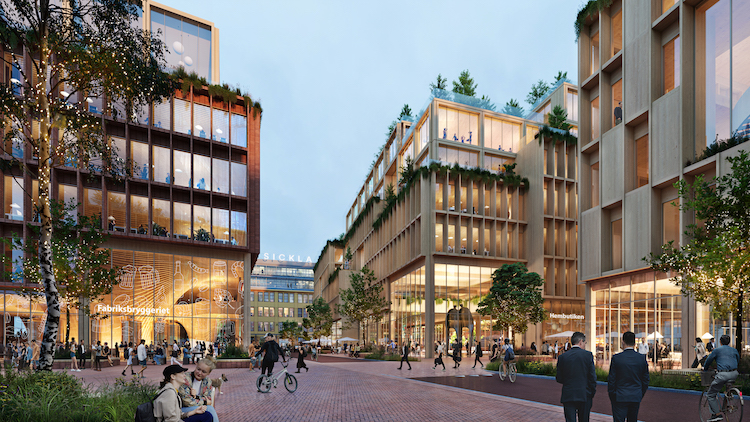
Swedish real estate company Atrium Ljungberg is to build Stockholm Wood City, which will be the largest in the world. The project is set to begin in 2025, with the first buildings expected to be completed by 2027.
Covering more than 60 acres, Stockholm Wood City will provide 7,000 office spaces and 2,000 homes in Sickla, Southern Stockholm. The aim is to create a vibrant urban environment with a mix of workplaces, housing, restaurants, and shops.

Sustainability showcase of Wood City
The project’s vision is to showcase the potential of renewable building materials and contribute to sustainability. Buildings are significant contributors to global CO2 emissions, so the use of wood as a construction material can reduce the climate impact by up to 50% and shorten construction time. Wood is also a renewable and locally sourced material, offering immense possibilities for sustainable urban development. Research indicates that wooden buildings improve air quality, reduce stress, increase productivity, and also store carbon dioxide over their lifespan.
In addition to its environmental benefits, Stockholm Wood City addresses the shortage of workplaces in the southern part of Stockholm, reducing commuting times. The project focuses on self-produced, stored, and shared energy, aligning with Sweden’s national agenda on energy supply and efficiency.
Sustainable architecture
Sweden is committed to achieving carbon neutrality by 2045, and the construction of high-rise wooden structures is part of this climate goal. However, it is the proliferation of wooden houses and structures that truly contributes to lower environmental and climate impacts. The country’s commitment to sustainable architecture is rooted in responsible forest management. For every tree cut down, at least two new ones are planted, ensuring a continuous supply of construction materials. Swedish architects combine the renewable nature of wood with technological advancements to create innovative structures that significantly. reduce construction time. Wood’s strength and lightness enable vertical construction in existing urban environments. This allows for building expansion and the integration of timber-on-top infills and other inventive techniques.
Sweden is home to other notable sustainable wood buildings, including the Bergaliv hotel on Åsberget Mountain. Bergaliv Lofthusen features three rooms stacked on top of each other on an abandoned ski slope. The nature room is closest to the ground, followed by the living area, which is the only heated space, and finally, the vista point at the top. In recognition of its innovative design, Bergaliv Lofthusen was nominated for the prestigious Swedish Wood Award in 2020.
Nature and innovation
Combining nature and innovation, The Wood Hotel, in one of the world’s tallest wood buildings Sara Cultural Center, showcases the best of Scandinavian design. Constructed with locally sourced wood, The Wood Hotel offers an impressive panoramic view of Skellefteå and boasts 205 modern rooms and suites, three restaurants, bars, as well as a rooftop spa.
For a truly extraordinary stay, Arctic Bath offers a floating hotel experience. The main building resembles a log jam, and the construction utilizes local materials with minimal environmental impact. The hotel consists of 12 rooms, six of which are floating cabins near the water’s edge, accessible via a footbridge. The remaining six cabins are on the tree-lined shore and accommodate up to five guests.
Sweden’s commitment to sustainable architecture and the use of wood as a construction material highlights the country’s dedication to environmental responsibility and innovative urban development.
The images are credit of Atrium Ljungberg/Henning Larsen.



